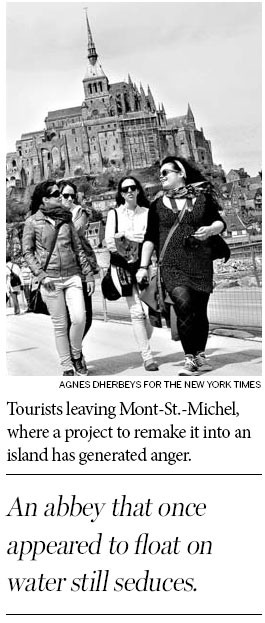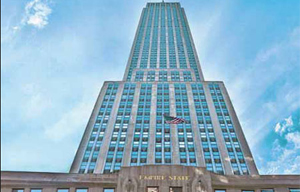Restoring the sea to an island
Updated: 2013-05-06 10:23
By Steven Erlanger (The New York Times)
|
|||||||||||
MONT-ST.-MICHEL, France - A dispatch in The New York Times in August 1944 described the view American soldiers had of Mont-St.-Michel, seeming "to float on the sea as gracefully as a ship under full sail, catching all the changing colors of the clouds."
Since then, tons of silt have built up around the island, attaching it to the land. The main culprit appears to be a causeway, built in 1879, that linked the monastery to the mainland but disrupted the movement of the waters. The problem was worsened in 1969, when the government built a dam on the Couesnon River to protect farmlands from high tide, but one result was to further reduce the power of the river to push the silt back into the sea.
A visitor here can still feel awe, especially at dawn and dusk, when the light spreads over the salt flats and the sea, or streams through the cloister and stained glass of the Abbaye du Mont-St.-Michel, known as La Merveille since at least the 12th century.

About 2.5 million visitors come to Mont-St.-Michel annually. But the number was down 9 percent last year, and not only because of the global economic crisis, particularly acute in Western Europe.
A $285 million project to restore the sea to Mont-St.-Michel, and consequently to move cars away from its base to parking lots nearly four kilometers away, has created confusion for tourists - and warfare between businesspeople and the local government.
Work started in 2005, but it is only now touching the commercial heart of the town. Angry demonstrations were staged at a meeting to review and revise how visitors are transported from the parking lots. Most contentious, the price of parking was increased to $16 from $11.
The fixed causeway that blocks the tidal movement will be replaced by a curving bridge that will appear to float on the water. The tip of the bridge will be inundated by spring high tides for a few hours a few days a year, symbolizing the island.
Cyrille Guillaume, the maitre d'hotel of the Auberge St.-Pierre, said that receipts were down 30 percent in the evenings, and "at least half of the 30 percent comes from the new difficulty of access."
He compared the new system to "a hostage taking," saying that "if access is bad, business is bad."
Jean-Marc Boure, the state-appointed administrator of the abbey, is also troubled. He supports the project to restore the sea and the beauty of the Mont, to bring "order" to the visiting process and to stop "the invasion of cars and buses." But he, too, complains about the drop in visitors.
Christophe Maisonobe, the operational director of the project, said that without it the Mont would have been completely landlocked within 30 years.
The mayor, eric Vannier, said the desilting project "is much bigger" than the squabbles over parking.
"It's an environmental project to preserve the magical effects of the tides," he said, so the Mont "becomes again what it was a century ago, this marvel of the West in the middle of the sea."
|
|
|
Related Stories
A camper's life traveling the open road 2013-05-01 16:12
Paying the price to travel 2013-05-01 15:10
More Chinese travel overseas, study reveals 2013-04-25 09:18
Travel Agency Special: Planet Travel always gives you a world of choice 2013-04-22 10:08
Today's Top News
Renewed interest in mission to Mars
Suspects accused of selling tainted pork
Xi pins hope on youth for innovation, advancement
China playing bigger role in Middle East
FM wraps up tour on
note of stability
Museum window vandalized
Seawater can save thirsty country
New markets buy big at trade fair
Hot Topics
Lunar probe , China growth forecasts, Emission rules get tougher, China seen through 'colored lens', International board,
Editor's Picks

|

|

|

|

|

|







